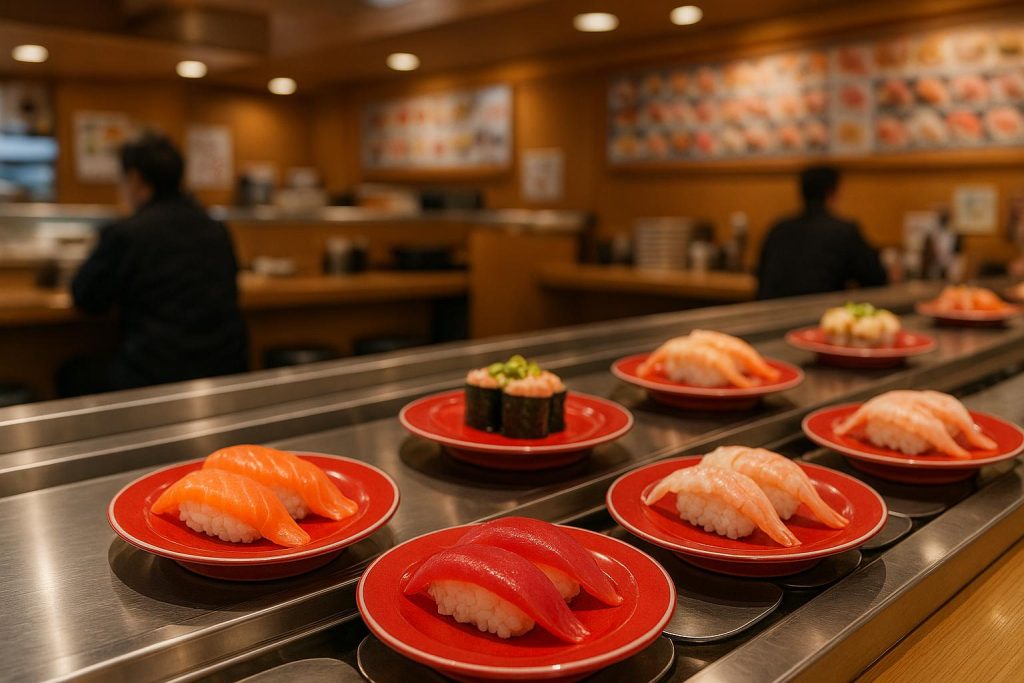Introduction to Conveyor Belt Sushi Restaurants
Conveyor belt sushi, known as kaiten-zushi in Japanese, is a unique dining experience where dishes are placed on a conveyor belt that continuously moves around diners’ tables. Originating in Japan during the 1950s, this innovative concept allows patrons to select dishes as they come by, thus offering a flexible and engaging dining experience. Not confined to Japan alone, kaiten-zushi has seen global expansion, becoming a beloved dining option worldwide.
How It Works
The process at a conveyor belt sushi restaurant is simple yet fascinating. Small plates with various sushi types are placed on a rotating conveyor belt that travels through the restaurant’s seating area. Customers may choose any plate they desire, reducing the need for traditional ordering methods. Typically, plates are color-coded to denote pricing, allowing diners to enjoy budget-friendly meals while indulging in their favorite sushi choices or trying something new.
Menu Variety
Conveyor belt sushi restaurants offer a diverse menu that caters to varying culinary preferences. The selection includes common sushi types like nigiri and sashimi, alongside rolls featuring both traditional and novel ingredients. For those not inclined towards sushi, additional menu items such as tempura, edamame, and miso soup are often available. This extensive selection ensures every diner finds something delightful, making it accessible for sushi aficionados as well as newcomers to Japanese cuisine.
Advantages of Conveyor Belt Sushi
Dining at a conveyor belt sushi restaurant presents various advantages. A notable benefit is the immediacy of service; diners can begin enjoying their meal as soon as they are seated. This efficient setup minimizes wait times for food preparation, making it a suitable option for those with limited time. Also, the format encourages sampling and sharing, allowing diners to taste small portions of diverse dishes without the need to order full servings. This approach reduces food waste and enhances the culinary experience.
Cultural Impact and Global Spread
Initially rooted in Japanese culture, conveyor belt sushi has transcended national boundaries and become a global phenomenon. Its popularity is particularly pronounced in regions with a high appetite for Japanese cuisine. This expansion not only introduces diners to the varied elements of Japanese gastronomy but also enriches their experience by providing an interactive and modern approach to dining. Interested individuals can explore more about conveyor belt sushi and find locations worldwide through resources such as the Japan Guide, which offers detailed insights into different restaurants and kaiten-zushi styles.
History and Evolution of Conveyor Belt Sushi
The origin of conveyor belt sushi is credited to Yoshiaki Shiraishi, who came up with the idea in the 1950s. His motive was to serve sushi quickly without compromising quality or customer service. After observing conveyor belts at a beer factory, he implemented the concept into his restaurant. This idea revolutionized the sushi dining experience by making it more accessible and efficient.
The Initial Phase
Shiraishi’s innovation faced skepticism initially; however, it began gaining favor due to its novelty and efficiency. The first conveyor belt sushi restaurant, Mawaru Genroku Sushi, featured a conveyor belt that decreased labor costs and boosted customer turnover. Customers were fascinated by the self-service aspect, which complemented the fast-paced lifestyle in urban areas.
Technological Developments
Over time, conveyor belt sushi restaurants have embraced technological advancements to enhance the experience. Many restaurants now employ digital screens to display information about each dish, allowing diners to learn about their choices in real-time. Some establishments have integrated automated systems to offer customized orders directly to tables using monorail-like devices, blending efficiency with personal service.
Fusion and Innovation
As kaiten-zushi spread across borders, it began incorporating local flavors to suit regional palates. For instance, in Western countries, fusion sushi options with popular local ingredients have become commonplace, widening the appeal to a broader audience. Restaurateurs are continuously experimenting with new flavors and presentation styles, keeping the dining experience fresh and exciting.
Impact on Sushi Culture
Conveyor belt sushi has significantly affected sushi culture by democratizing access to this traditional Japanese dish. It has shifted the perception of sushi from an exclusive, high-end cuisine to a casual, everyday dining option. This democratization has broadened the consumer base, introducing sushi to individuals who may not have previously considered it due to cost or accessibility concerns.
Sustainability and Conveyor Belt Sushi
In recent years, the food industry has placed a significant focus on sustainability, and conveyor belt sushi restaurants are no exception. This focus encompasses various aspects, from ingredient sourcing to waste reduction and energy efficiency.
Sourcing Sustainable Seafood
Ensuring sustainable seafood sourcing is critical for sushi restaurants. Many conveyor belt sushi establishments are increasingly committed to purchasing fish from responsible fisheries, which protects ocean ecosystems. Restaurants may work with suppliers certified by reputable organizations to guarantee sustainable practices.
Waste Reduction Techniques
Conveyor belt sushi restaurants are implementing innovative waste reduction strategies to minimize their environmental impact. The small plate format naturally curtails food waste since diners can try numerous dishes without the pressure of ordering full portions. Any uneaten sushi is often repurposed into other culinary creations or composted, adhering to zero-waste principles.
Energy Efficiency
Technological improvements have made modern sushi conveyors more energy-efficient. Many restaurants are adopting energy-saving equipment for refrigeration and lighting, which reduces overall energy consumption. The use of LED lighting and energy-efficient appliances also enhances the restaurant’s sustainability footprint.
Future Trends in Conveyor Belt Sushi
Looking ahead, the focus on sustainability and technological integration will likely remain significant in the conveyor belt sushi industry. The adoption of green innovations will continue, as will the expansion into new international markets. Additionally, advancements in artificial intelligence and automation may further refine and personalize the dining experience, maintaining kaiten-zushi as a beloved culinary trend worldwide.
By embracing sustainability and innovation, conveyor belt sushi restaurants are positioned to adapt to evolving consumer preferences while continuing to offer a dynamic and enjoyable dining experience.













